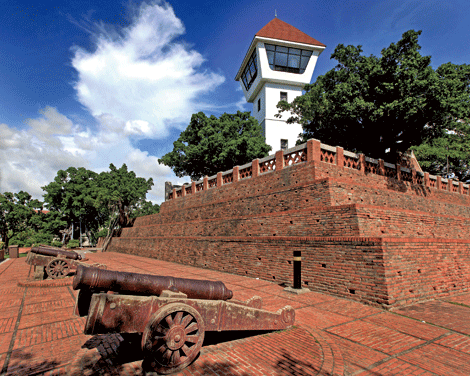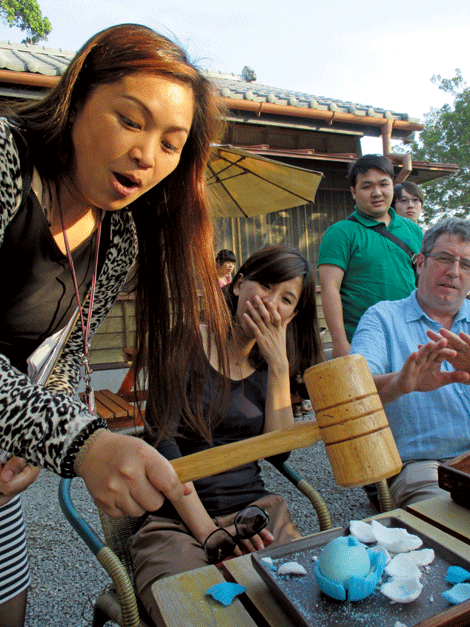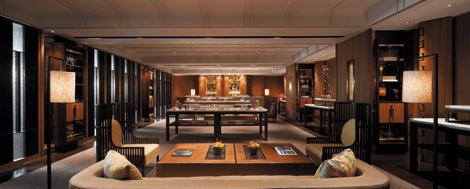It’s a real pity that more and more cities in Asia-Pacific are sacrificing their heritage buildings in the name of “progress” – usually a euphemism for developers’ shiny master plans for the future. Hong Kong, as we sadly know, is a prime example; Singapore in the 1990s was tearing down exquisite shophouses in Chinatown until some far-sighted minds in government put a stop to the wrecking ball; while in Manila, stagnancy has claimed the 17th century Intramuros complex, which still has its sturdy walls and a turret or two, but not much to boast about in terms of exciting restoration initiatives to attract a new generation of visitors.
It’s a pleasure, therefore, to discover the district of Anping, part of Tainan City on the southwest coast of Taiwan, which is a pearl in the preservation efforts of proud local residents and officials alike. This much-storied town has felt the hand of many masters, from the Dutch colonisers to the Koxinga period, the subsequent Qing administration to the Japanese regime – a rich mix of bygone cultures that adds to its overall character. The Tourism Bureau of Taiwan further burnished this unique reputation last year by including Anping in its list of “Top 10 Tourist Towns”.

Anping Fort
Daoyuan – Anping’s early name and probably also where the name “Taiwan” originates – was originally an islet separated from Tainan by a shallow lagoon. As such, it attracted foreigners as a good place to set up base, both for trade and expanding power, but due to changing ocean currents, over time it silted up until it finally joined the mainland.
The Dutch East India Company (VOC) led the way, establishing Fort Zeelandia in 1624. Thirty-seven years later their fortifications were attacked by Ming general and loyalist Koxinga, as he fled from the emergent Qing dynasty on the mainland. With the help of 25,000 soldiers on hundreds of ships and junks, he took Fort Zeelandia and renamed it Anping – the name stuck and has remained to this day. Koxinga established the beginnings of the salt-making industry, which gained a good reputation for Tainan, and even invited the British to set up a commercial trading post. The Japanese soon saw a business opportunity in salt making and hotfooted it to Anping, adding their expertise to expand the market.
“Shio”, 10 minutes away from Anping’s old precinct, is a restored Japanese salt merchant’s house and store that today sells artisanal salt, as well as salt-encrusted, hard-boiled eggs painted in a rainbow of hues, which visitors enjoy on the pleasant backyard lawn. Capitalising on Taiwanese people’s penchant for anything kawaii (“cute” – a uniquely East Asian element of pop culture), most visitors are instantly charmed by an enormous display of salts corresponding to each day of the year and accompanied by a character attribute. No explanation is given as to how each type of salt matches each date, but during my trip everyone, including myself, seemed charmed with what they discovered.

Shio salted eggs
From 1864 onwards, Anping became a buzzing entrepôt swarming with wheelers and dealers from England and Europe. The five most prominent were Tait & Co, Bains & Co, Boyd & Co, Wright & Co and Julius Mainich and Co. The estates of Tait & Co and Julius Mainich are two of the best preserved, and these should not be missed during a walking tour of the neighbourhood.
In the Tait & Co Merchant House, a meticulously laid out exhibit of 17th century household artefacts affords a glimpse of daily life in centuries past. But in truth, it’s the Anping Treehouse that claims the greatest attention from visitors to the estate. Unlike the usual playhouse nestled in a tree, a group of banyan trees have taken over the ruins of Tait & Co’s warehouse – with a vengeance. Aerial roots, vines and trunks have crept up on the abandoned structures until their stranglehold was complete and irreversible. It’s now hard to discern whether the walls support the trees or vice versa.
A sturdy black metal walkway wends its way above the overgrowth, and viewing platforms offer the best panorama of the trees’ advance as well as the lush mangroves of the Yanshui River beyond. Weekends tend to be rather chaotic and overrun with sightseeing hordes, so if you have any fantasies of wandering through the rooms and into the past, choose a weekday for your visit.
As a former Dutch enclave, many of Anping’s streets date back to the 17th century, especially those at the base of Anping Fort such as Yanping and Xiaozhong, near Haishan Hostel. These two also run off into smaller but equally colourful lanes and alleys, where simpler lives play out in unburnished surroundings, providing numerous photo ops for the intrepid observer.
See those lion heads with spears across their mouths on some of the door lintels? The practice, said to protect the house and its residents against evil, is slowly dying out. Or those lantern-shaped window frames, which give the plainest structure a charming appearance? Not many turn up these days in more modern homes.
The swell of vendors, eateries, shops and gaming stalls, particularly on weekends, creates a nostalgic yearning for the days when gatherings like these provided entertainment and excitement for countryside communities, a chance for neighbours to catch up and young people to hang out with their peers and flirt with the opposite sex.
Veteran hotelier Wolfgang Krueger, former general manager of Shangri-La’s Far Eastern Plaza Hotel Taipei, waxes lyrical about Anping’s great sense of place: “One can feel what it must have been like when the Dutch first arrived here. In a wonderful way, and despite the progress that Tainan has seen since becoming the IT hub of Taiwan, Anping has stayed remarkably historic and retains that small town character.”
GETTING THERE
The High-Speed Rail (Gao Tie) is undoubtedly the best option available. Trains arrive in the new station about 30 minutes from the city centre. Fares between Taipei and Tainan cost NT$1,350 (US$45) for standard class and NT$1,780 (US$59) for business class for the 1-hour, 45-minute journey. Between Taoyuan and Tainan, standard class seats cost NT$1,190 (US$40) and business class NT$1,590 (US$53). Regular train services also run from Taipei and Kaoshiung to Tainan, arriving after many stops in the old train station near Shangri-La’s Far Eastern Plaza Hotel. From downtown, a Scenic Spot Shuttle Bus departs regularly for the 30-minute journey to Anping. For those who must fly, China Airlines will launch thrice weekly flights between Tainan and Hong Kong on July 18.
www.thsrc.com.tw/en, www.china-airlines.com
WHAT TO EAT
Known as the “city of snacks” (the right term should really be “snackers” in our opinion), don’t leave town without trying “coffin toast”, which is fried bread in the shape of – you guessed it – a coffin, stuffed with various goodies such as chicken, beans, peas and seafood, and dunked in a variety of creamy sauces; oyster omelette, much like the Japanese okonomiyaki; and oysters and thin noodles, rice cakes and shrimp rolls. And of course, good old pearl milk tea!
WHERE TO UNWIND
Just because Tainan is a quiet, cultural city doesn’t mean it doesn’t know how to let down its hair. For that, head for Hai-an and He-wei roads where bars, cafés and a huge night market are to be found doing good business nightly. Along Shennong Street, off Hai-an Street, are artists’ workshops and designer studios ensconced in restored 1930s residences. Crumbly façades have been turned into canvases for cutting-edge art like Blueprint bar, which operates out of a century-old building and whose frontage was made to resemble a blueprint by well-known architect Liu Guo-cang.
Tried and Tested: Shangri-La’s Far Eastern Plaza Hotel Tainan

BACKGROUND Both Shangri-La’s Far Eastern Plaza Taipei and this Shangri-La in Taiwan’s oldest city share the same owner. It opened in 2009, adding a much-needed contemporary product to a market that still shows a dearth in this department.
WHAT’S IT LIKE? Just like its more established sibling in Taipei, this property follows the shape of a soaring column with the guestrooms starting from the 11th floor and ending at the 37th floor. A handsome sculptural piece at the reception desk, which appears in many of the hotel collaterals and website, seems to echo the design of the building. A refreshing understated charm runs throughout the entire property, including the guestrooms (unlike some other Shangri-Las that are not shy about proclaiming their Oriental-ness), but it was a bit jarring to spot a prominent display of elves in a whimsical garden setting in the lobby.
WHERE IS IT? The hotel is located next to the National Cheng Kung University, Far Eastern Department Store and old Tainan train station. The high-speed railway station (Gao Tie) is 15 minutes away by car, while Tainan’s domestic airport is 25 minutes’ drive away.
ROOM FACILITIES At 50 sqm, my deluxe room felt more like a mini suite, but I would have liked to reposition the work desk, which looked out to the city – others may feel differently, but I want no distractions when I’m working. However, the electrical outlet panel was conveniently embedded on the left side of the table. The 42-inch flatscreen TV was mounted on the wall facing the bed, which did away with the need for a sideboard. Controls for the lights and curtain were located beside the bed. Shangri-La should be congratulated on promoting a chain-wide free internet policy, as this removes the anxiety about connectivity whether in one’s guestroom or moving about the hotel.
RESTAURANTS AND BARS These are spread out over different levels, with the Lobby Lounge and The Shop (selling breads, pastries and take-out coffee) on the ground level; Mezzanine Bar on the second floor, the Café for all-day dining on the 10th floor and Shanghai Pavilion, serving dim sum and Huaiyang cuisine with a panoramic city view, on the topmost 38th floor.
BUSINESS AND MEETING FACILITIES As with several Taiwanese hotels, Shangri-La Tainan boasts an auditorium on the ninth floor seating 250 people, while nearby is a boardroom for 18. Most of its meeting rooms are found in basements 1 and 2, including the stylish Marquee Living Room, which can host a reception for 100 guests.
LEISURE FACILITIES Located on the seventh floor is an outdoor heart-shaped pool with a set of cabana-style divans, and a health centre with all the latest equipment. The spa offers an extensive menu of therapies, with treatments such as the deep tissue massage, targeted back massage and leg massage all good for the worn-out business traveller.
VERDICT it was a real pleasure to retire at night to the spaciousness of the deluxe room. I couldn’t help wishing the non-premium room categories of the future would follow this template.
TESTED BY
Margie T Logarta
HOW MANY ROOMS?
333 guestrooms and suites, comprising 28 Superior rooms, 211 Deluxe rooms, 22 Executive rooms and a Plaza Suite, while on the Horizon Club floors – whose occupants enjoy the use of the 24th floor club lounge – there are seven Horizon Club Superior rooms, 39 Horizon Club Deluxe and three Horizon Club Executive rooms, two Horizon Plaza Suites and a Presidential Suite. Wheelchair-accessible rooms are available.
ROOM HIGHLIGHTS
The well-known Shangri-La brand of service that provides free wifi throughout the entire hotel and attentive service that manages not to be intrusive.
PRICE
Deluxe room stay in mid-September starts from US$105
CONTACT
89 Section West, University Road, Tainan, 70146, Taiwan; tel +886 6 702 8888; www.shangri-la.com








